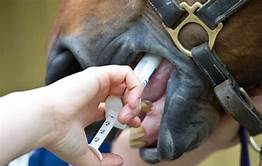
The purpose of rotating dewormers is to get a broader spectrum of coverage for your horse, since each type of dewormer has efficacy against varying parasites and at different stages of the parasite’s life cycle. So rotating dewormers gives horses better coverage against the four major types of internal parasites that infect horses: strongyles, ascarids, pinworms and bots.
Another reason for rotating dewormers is to prevent parasites from developing resistance to the chemicals used in deworming. Until ivermectin came along, resistance was a constant problem with dewormers. With the advent of ivermectin, two or three decades ago, a new “class” of dewormer was established, and it promised that resistance would never be a problem. And so far, that is true but scientist believe that if we over-use ivermectin, that eventually some worms will become resistant. So, we continue to recommend rotating dewormers, to protect the efficacy of ivermectin.
Anthelmintics are the drugs we use to deworm horses and there are different classes of chemicals available. Rotation refers to rotating the class of drug used to deworm. The most popular dewormers fall into three classes: the benzimazoles (Panacur, Anthelcide), pyrantels (Strongid) and the avermectins (ivermectin and moxidectin). I use all four of these chemicals in my rotation program.
In my opinion, Ivermectin is still a superior class of dewormer because it has a high efficacy, is inexpensive (generic available), available in liquid or paste, is very safe to administer and won’t hurt other farm animals. Many vets will tell you to give the whole tube of ivermectin to each adult horse because overdosing is hard to do and under-dosing is a waste of money. Ivermectin also kills the skin parasites that cause summer sores.
In the last decade, another new dewormer was developed with the advent of moxidectin (brand name Quest Gel). This dewormer has many promising traits such as being longer lasting in the horse’s system, therefore requiring fewer doses. However, moxidectin should be used with discretion since it is easier to overdose a horse and cause a toxic reaction. It should, in my experience, also be used with caution on geriatric horses or very lean horses.
How often to deworm is a whole other question, but it basically depends on the density of your horse population and the hygiene practices at your facility. Climate, humidity, rainfall and the age of the horses are also considerations in how often you deworm. The more horses on a smaller parcel, the more often you need to deworm. There is speculation that horses kept in a totally natural environment (a pasture big enough that the herd has all the range it wants) may never need deworming. In the wild, horses will not eat where they defecate. Therefore, good stable hygiene is a major factor in how often horses need deworming. You should consult your vet about the frequency and rotation of deworming that is most effective for your area.
Traditional research indicates that it is best to concentrate deworming doses in the summer months, while more recent research indicates it is better to concentrate in the winter months when the worms are in their early life cycle. Given this contradiction, what makes the most sense to me is to deworm year-round.
We deworm every two months, six times a year, which is a little on the high side, but it helps keep the horses looking their best (some show horses are dewormed every month). We use ivermectin every other rotation and in-between we use strongid, panacur and moxidectin. I do not give moxidectin to any geriatric horses or any horses in an unthrifty condition. We deworm foals every month for their first year of life with ivermectin every other month, and rotating in-between with panacur and strongid.
Once every couple years, on my personal horses, I invest in a Panacur Power-Pac, for about $50 per horse). It is a double dose of panacur every day for five days. This takes care of any residual parasites that our regular program is not catching. We will also use the Power Pac on any horses that come to us in an unthrifty condition, especially if it has a questionable deworming history. It is a safe and effective way to get a horse up to par in his condition right away.
For the greatest efficacy, it is best to deworm all horses in a facility at the same time. For that reason, any horses that come into my facility either as a boarded horse or a horse-in-training, go onto my deworming schedule and I take over the administration of dewormers and bill the owner.
Many facilities do routine fecal egg-counts of their horses and only deworm when the egg count reaches critical levels; this is called target dosing. These facilities report that their horses are in better health and that the cost of deworming is drastically reduced (research indicates up to a 75% reduction in doses is possible). Also, resistance becomes less of a problem, since horses are not being needlessly treated.
Many horse owners and some large facilities have started using a daily feed-through dewormer and I have heard of good results with this program, but not tried it myself. For me, it is too expensive and you still have to deworm with ivermectin twice a year, because the feed-through dewormers do not kill bots. Also, if horses are kept in group paddocks, it is very difficult to administer.
One more thought on, we always wait until after the first hard frost of the year for the fall deworming and we always use ivermectin, because it is more effective in killing bots, (those pesky yellow specks that horses get on their legs in the fall are bot fly eggs).
Article written by Julie Goodnight for http://cha-ahse.org/store/pages/177/ROTATION-OF–HORSE-WORMERS.html



